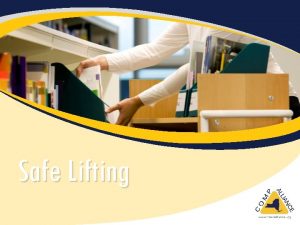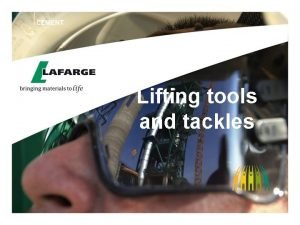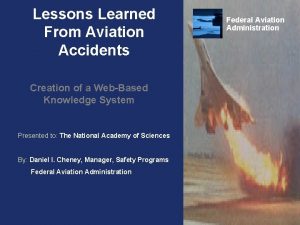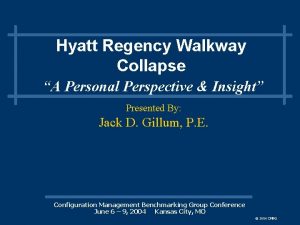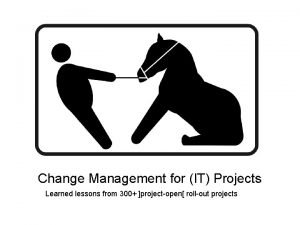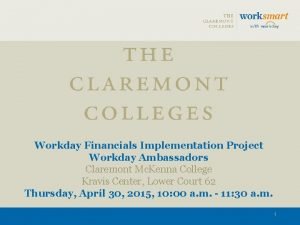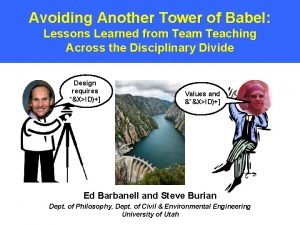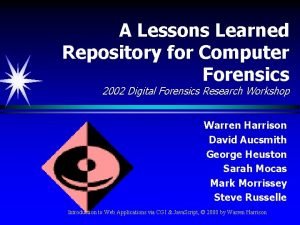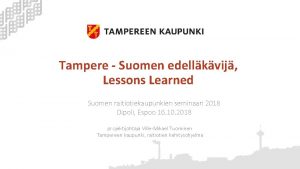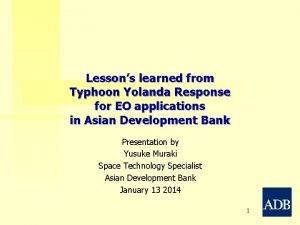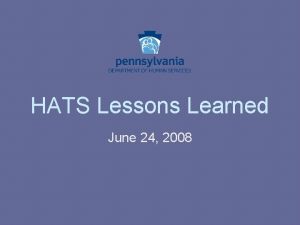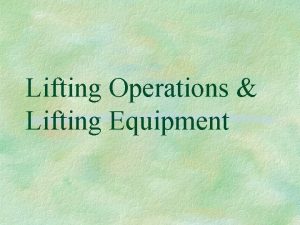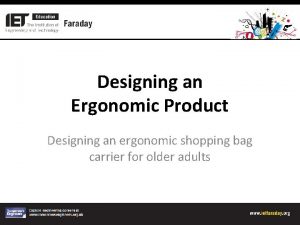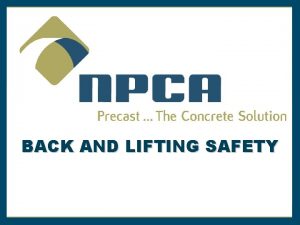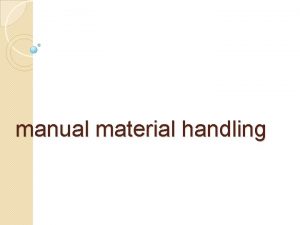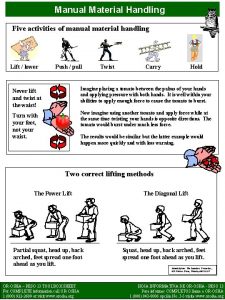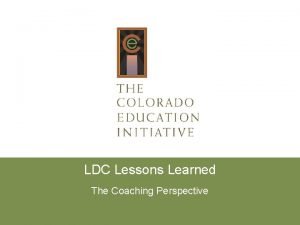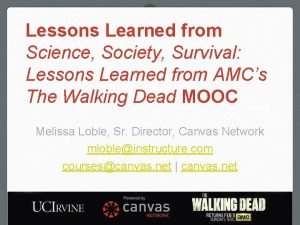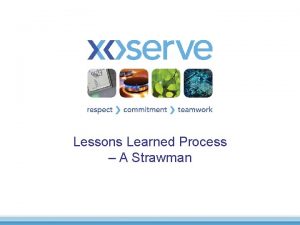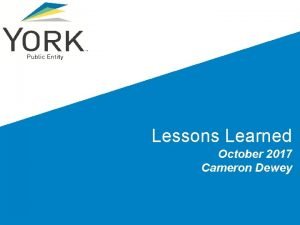Enforcement Lessons Learned Ergonomic Manual Lifting and Material












- Slides: 12

Enforcement Lessons Learned Ergonomic Manual Lifting and Material Handling Investigation Presented to EFCOG Regulatory & Enforcement Technical Subgroup Debbie Jenkins ORNL Enforcement Coordinator October 21, 2015 ORNL is managed by UT-Battelle for the US Department of Energy

Several incidents indicated weaknesses in material handling activities 2013 June Employee diagnosed with hernia (surgery required) after lifting long, heavy pipe with 3 other employees 2014 November Employee suffered torn bicep (surgery required) while placing electric motor on storage cabinet March 1580 lb chamber tipped over onto employee, resulting in fractures and lacerations (surgery required) June New 800 lb glove box tipped over and fell off stand during installation, nearly hitting an employee Comprehensive investigations and detailed corrective action plans for each event 2 Business Sensitive August 2600 lb tank fell from a forklift pallet while being transported between buildings at SNS

What have we learned? Staff did not maintain a healthy respect for what can go wrong Supervisor presence in the field was inadequate We missed opportunities to learn Staff and supervisors did not exhibit a questioning or suspend work ORNLattitude permitted to conduct internal investigation of events. when things did not seem right Our programs and work processes did not effectively support safe work performance 3 Business Sensitive

We conducted a common cause analysis – material handling/lifting events • Eight events were included in the analysis • Facilitated session with attendees who were part of investigations, root cause analysis determinations, and/or individual ORPS and NTS reports • Identified common causes and crosswalked to current corrective actions to identify gaps • Corrective actions were determined to be comprehensive – six additional actions identified to strengthened proposed strategy 4 Business Sensitive

Six common cause statements were identified 1. Personnel did not have a full appreciation of the unique hazards associated with material handling (e. g. , load configuration and instability) and their impact on safe work execution. 2. Supervisors and workers did not have a common understanding of what constituted “skill of the worker” activities, leading to inconsistent assumptions regarding hazard identification and work execution. 3. Supervisory oversight did not assure that personnel were adequately prepared to commence work through a pre-job brief or other mechanism and that expectations were understood and being met. 4. Personnel failed to reassess hazards and controls when changed conditions were encountered. 5. “Prior successful execution of material handling activities” led workers to infer that the risk of failure was low and additional planning was not necessary. 6. Information related to prior events was not communicated in a manner that enabled employees to recognize the applicability to their work activities. Weaknesses in our safety culture contributed to material handling events 5 Business Sensitive

Corrective actions focused on event specific issues, as well as underlying safety culture issues • Some corrective actions focused on event-specific issues • Significant effort spent on developing actions to address cultural issues – Key safety principles codified in “The Safe Conduct of Research” – Development/Implementation of LOSA – Sustained commitment to Mentoring Program • Efforts to change conversation regarding safety – Focus on Hierarchy of Controls – “How much can I lift? ” versus “What is the best way to lift it? ” – Knowledge based approach – Improvements to Management Observation Program Actions focused on cultural aspects of employee interactions, not just creating more paper 6 Business Sensitive

In August 2014, Notice of Intent (NOI) to Investigate was received from OE • NOI transmitted to ORNL • On-site Investigation Aug 5 2014 Aug 26 • Document Request Received Sep 16 • Document Submitted Jun 16 • PNOV Received Nov 4 -6 2015 • Enforcement Conference 7 Business Sensitive Mar 24

Document Request was programmatic, not event specific • Many documents requested were unrelated to events under investigation – “Safety and health assessments of the jobs with material handling, lifting, and ergonomics indicated as potential hazards; and the controls that were implemented to control the hazards • Maintenance – 831 documents • Accelerator operations – 967 documents • Reactor operations – 115 documents • Research operations – 788 documents • Thousands of work control documents reviewed to identify those with identified hazards • Significant unallowable costs Communication with OE Enforcement Specialist is key! 8 Business Sensitive

Three-day onsite investigation conducted • Prep meetings held with those being interviewed • Presented opening briefing with our perspective of issues • Tour of ORNL facilities/locations where events occurred • Interviews conducted – Group interviews – No UT-Battelle presence – Did not interview management personnel – Interviews included team member at remote location (teleconference) 9 Business Sensitive

Office of Enforcement investigation report • Investigation report was factually accurate – Did not identify any new, significant issues – Identified compliance issues related to requested documents that did not involve events in question – Did not provide factual accuracy comments • Regulatory citations were consistent with our event investigations • One area of disagreement - common cause analysis did not identify all relevant factors – Addressed this issue during the enforcement conference 10 Business Sensitive

Enforcement Conference held at ORNL • Emphasis on scheduling with 30 days of receipt of investigation report • Prepared enforcement presentation – significant discussion on strategy for conference • Conducted three dry runs • Three presenters – Laboratory Director – Deputy Director for Operations – ESH Director 11 Business Sensitive

Enforcement Outcome • Final PNOV - $131, 500 (mitigated) • 50% mitigation received – Post incident measures including a common cause analysis of ergonomics and material handling events that occurred from June 2013 to August 2014 – Identified the need to address laboratory cultural issues to improve material handling performance – Enlisted assistance of external SMEs to drive the necessary long-term behavioral and performance changes among management and field personnel 12 Business Sensitive
 Ergonomic lifting techniques
Ergonomic lifting techniques Lifting tools & tackles
Lifting tools & tackles Lessons learned faa
Lessons learned faa Who was responsible for the hyatt regency walkway collapse
Who was responsible for the hyatt regency walkway collapse Change management lessons learned
Change management lessons learned Workday claremont colleges
Workday claremont colleges Lessons learned from mount carmel contest
Lessons learned from mount carmel contest Hydrotopia
Hydrotopia Lessons learned repository
Lessons learned repository Lessons learned suomeksi
Lessons learned suomeksi Lesson learned in typhoon yolanda
Lesson learned in typhoon yolanda Lessons learned ground rules
Lessons learned ground rules Lessons from the ants
Lessons from the ants
